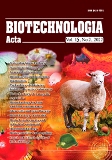ISSN 2410-7751 (Друкована версія)
ISSN2410-776X (Електронна версія)

Biotechnologia Acta Т. 15, No. 2, 2022
P. 56-57, Bibliography 3, Engl.
UDC: 598.115.33
https://doi.org/10.15407/biotech15.02.056
ACTION OF VENOM OF VIPERA SNAKE OF UKRAINE ON BLOOD COAGULATION in vitro
1Palladin Institute of Biochemistry of the National Academy of Sciences of Ukraine, Kyiv
2Educational and Scientific Center “Institute of Biology and Medicine” of Taras Shevchenko National University of Kyiv, Ukraine
3 V. N. Karazin Kharkiv National University, Ukraine4 Society for Conservation GIS
Aim. In this study we focused on the search of fibrinogen-targeted proteases in the venom of Vipera renardi, Vipera nikolskii and Vipera berus. Venom of Vipera berus was also fractionated on Q-sepharose and action of separated fractions on human blood plasma, platelets and red cells was studied.
Methods. Analysis of protein mixtures was performed using SDS-PAGE. Аction on the blood coagulation system was analyzed using the APTT assay. Identification of protein components with fibrinolytic activity was performed using enzyme-electrophoresis with fibrinogen as the substrate. Fractionation of V. berus venom was performed on Q-sepharose using FPLC system Acta Prime. Action of separated fractions on ADP-induced platelet aggregation in platelet rich blood plasma was analyzed using Aggregometer AP 2110. Hemolytic action of fractions was estimated using fresh human red cells. Amount of released hemoglobin was estimated by spectrophotometry on Optizen POP.
Results. All studied venoms had different protein compositions with major protein fractions in the range from 25 kDa to 130 kDa. Both V. berus and V. nikolskii venoms taken in 1:200 dilutions reduced the time of clotting in APTT test from 25 to 13 s. In contrast, V. renardi venom in the same dilution prolonged the clotting time from 25 s to 180 s that we assumed as the result of fibrinogen-specific protease presence. According to enzyme-electrophoresis data all studied venoms contained fibrinogen-specific proteases with the apparent molecular weights for V. berus, V. nikolskii – 25-55 kDa. and V. renardi – 55-75 kDa. Fractionation of crude venom of V. berus allowed obtaining several fractions eluted at different concentrations of NaCl: 0.1; 0.2; 0.3; 0.5 М. Non-binded fraction was also collected.
Conclusions. Thus, the components of Vipera venoms living in Ukraine can be used for basic biochemical research. At the same time, care should be taken in the case of envenomation, as the presence of fibrinogenolytic enzymes in the venom can lead to hemorrhage. Further characterization of fibrinogen-specific protease from V. berus venom is a promising task for biotechnology.
Key words: snake venom, Vipera renardi, Vipera berus nikolskii, Vipera berus berus, fibrinogenolytic action, fibrinogen-specific protease, APTT, enzyme-electrophoresis.
© Palladin Institute of Biochemistry of the National Academy of Sciences of Ukraine, 2022
References
1. Zinenko O., Tovstukha I., Korniyenko Y. PLA2 Inhibitor Varespladib as an Alternative to the Antivenom Treatment for Bites from Nikolsky’s Viper Vipera berus nikolskii. Toxins (Basel). 2020, 12(6), 356. https://www.ncbi.nlm.nih.gov/pmc/articles/PMC7354479/
https://doi.org/10.3390/toxins12060356
2. L. Ostapchenko O., Savchuk N., Burlova-Vasilieva. Enzyme electrophoresis method in analysis of active components of haemostasis system. АВВ. 2011, 2, 20–26. https://www.scirp.org/journal/paperinformation.aspx?paperid=3885 https://doi.org/10.4236/abb.2011.21004
3. Born G. V. Changes in the distribution of phosphorus in platelet-rich plasma during clotting. Biochem. 1958, 68, 695–704. https://www.ncbi.nlm.nih.gov/pmc/articles/PMC1200420/
https://doi.org/10.1042/bj0680695

